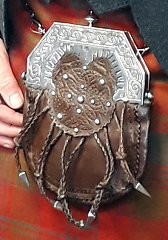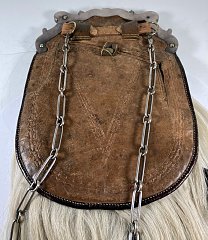|
-
2nd September 22, 08:04 AM
#1
Sporran Question
I was watching a video from USA Kilts about the origin of the knob atop a metal cantle. Their explanation makes sense though I sense it's missing something of in inaccurate in some manner. I've seen many photos of Victorian Sporrans. Most of them have a simple flap at the back of the sporran for coins and bank notes. Attire was more formal back then. I assume you'd have your jacket on all day. There would be some pockets to keep your tobacco and matches in.
The evolution of the sporran following the second world war makes a lot of sense. There was more to carry.
Here's the link to the video
https://www.youtube.com/watch?v=kp5HQ7BBoQ0
-
-
2nd September 22, 08:39 AM
#2
They got it mostly right. The catch in some old sporrans worked by pushing rather than pulling which is the way the MOD brass cantled sporrans worked.
Decorated finiales go back to the 19th century, rather than the mid-20th as they suggest. Finally, the post-WWII sporran styles are actually a return to those based on the older, pre-19th century styles.
Last edited by figheadair; 3rd September 22 at 09:26 AM.
-
-
3rd September 22, 06:02 AM
#3
 Originally Posted by piperalpha

I've seen many photos of Victorian Sporrans. Most of them have a simple flap at the back of the sporran for coins and bank notes.
Yes by around 1840 sporrans had evolved to having long hair (goat, often having horsehair extensions overlaying the goat) with non-functioning cantles. The back of the sporran now had a slot to reach inside, the slot covered by a plain leather flap fastened with a button or string.
That style was worn in the army and by civilians alike throughout the Victorian period.
Since the cantle no longer opened, knobs became mere decoration.
For some unknown reason, in Victorian times sporrans generally had either no knobs, or three knobs.
In the 20th century a single knob became standard, who can say why.
 Originally Posted by piperalpha

Attire was more formal back then.
In truth Victorian Highland Dress had a wide range of formality, from extremely plain Outdoor Dress (more plain than in the 20th century, for example flashes and kilt-pins often weren't worn) to quite ornate Evening Dress (more ornate than in the 20th century, with plaid, sword, powder-horn, pistols, etc being worn).
Proud Mountaineer from the Highlands of West Virginia; son of the Revolution and Civil War; first Europeans on the Guyandotte
-
-
3rd September 22, 06:33 AM
#4
Thanks gents,
It's nice to have that one cleared up a bit.
-
-
3rd September 22, 02:59 PM
#5
Thanks!
I just now put together this collage to show the 18th century style hinged cantle versus the Victorian style nonfunctional cantle, which demonstrates how the three functional knobs became mere decoration.
Top left: 1953 MOD cantle, you can see the side knobs which hold the two halves together creating a hinge. With some of these sporrans the side knobs also support the suspended leather bag, the top of the bag having holes on each side which slip over the knobs. The top knob operates the latch mechanism.
Top right: sporran with functional 18th century style cantle.
Bottom right: Victorian style sporran on which the cantle is more or less a decorative plate sitting atop the sporran. The side knobs have been moved up. All three knobs are mere decoration.
Bottom left: the back of the sporran showing the leather pocket with side gussets allowing it to be opened further, and leather flap. The cantle is held in place with tiny silver nails, missing in this example. Note that if you wear a leather belt it goes through the leather tabs, while if you wear a chain-strap it hooks onto metal loops on the back of the cantle.

Last edited by OC Richard; 3rd September 22 at 03:04 PM.
Proud Mountaineer from the Highlands of West Virginia; son of the Revolution and Civil War; first Europeans on the Guyandotte
-
The Following 3 Users say 'Aye' to OC Richard For This Useful Post:
-
3rd September 22, 11:51 PM
#6
 Originally Posted by OC Richard

Yes by around 1840 sporrans had evolved to having long hair (goat, often having horsehair extensions overlaying the goat) with non-functioning cantles. The back of the sporran now had a slot to reach inside, the slot covered by a plain leather flap fastened with a button or string.
That style was worn in the army and by civilians alike throughout the Victorian period.
Since the cantle no longer opened, knobs became mere decoration.
For some unknown reason, in Victorian times sporrans generally had either no knobs, or three knobs.
In the 20th century a single knob became standard, who can say why.
In truth Victorian Highland Dress had a wide range of formality, from extremely plain Outdoor Dress (more plain than in the 20th century, for example flashes and kilt-pins often weren't worn) to quite ornate Evening Dress (more ornate than in the 20th century, with plaid, sword, powder-horn, pistols, etc being worn).
Richard,
An useful summary. The one addition I would add is that towards the end of the Victorian era (the 1890s), the Celtic Revival saw a return to functioning cantles per the 18th century style but usually in silver. Henry Tatton, Ferguson and MacBean etc., were amongst the premier exponents of this style. here is my F&M'B one from 1896.

-
The Following 2 Users say 'Aye' to figheadair For This Useful Post:
-
4th September 22, 04:38 AM
#7
 Originally Posted by figheadair

Richard,
The one addition I would add is that towards the end of the Victorian era (the 1890s), the Celtic Revival saw a return to functioning cantles per the 18th century style but usually in silver. Henry Tatton, Ferguson and MacBean etc., were amongst the premier exponents of this style.
Yes indeed. It's an interesting period in sporran development rich in experimentation and variety, functioning hinged cantles with brown leather, buff leather, partial fur, full fur, targes, different sorts of tassels, etc.
It's a bit ironic that the return of functioning cantles with functioning knobs also saw a proliferation in non-functioning knobs, in some of those Celtic Revival sporrans

It seems to me that sporrans like this somehow evolved into the the modern seal "Evening Dress" sporrans which replaced the Victorian long-hair sporrans for Evening in the 1920s.

When the cantles become fixed you see various treatments in the back. Note that most of these cantles have a partial back plate.
Centre bottom is the solution eventually arrived at, getting rid of the cantle back plate so that the back panel can open, held by a stud closure.

Last edited by OC Richard; 4th September 22 at 05:34 AM.
Proud Mountaineer from the Highlands of West Virginia; son of the Revolution and Civil War; first Europeans on the Guyandotte
-
The Following User Says 'Aye' to OC Richard For This Useful Post:
-
4th September 22, 04:50 AM
#8
 Originally Posted by piperalpha

I've seen many photos of Victorian Sporrans...Attire was more formal back then.
Returning to the topic of the formality of Victorian Highland Dress, I could hardly have asked for a better illustration of the simplicity of Victorian "day" or "outdoor" attire than this gent.
Plain hose, plain shoes, no flashes. The typical informal Victorian "outdoor" sporran with completely plain leather cantle (no metal rim or badge) and plain brown-grey hair body (no tassels).
A utilitarian tweed jacket with plenty of pockets, indeed one often sees quite plain non-Highland cut jackets in Victorian Highland Dress.
Photo by J. Stewart, Inverness.

 Originally Posted by piperalpha

The evolution of the sporran following the Second World War makes a lot of sense. There was more to carry.
Sorry I missed that earlier. Did they say that in the video? It doesn't make sense, because there wasn't any evolution in sporrans in the post-WWII period, unless they're talking about the patent taken out by William Scott in 1953.
Hinged-cantle Evening sporrans did continue to be made, as far as I know, right from the late 19th century Celtic Revival ones right up through the 1960s.
Other than the W E Scott patent, it seems that the modern 20th century Traditional Highland Dress remained almost entirely unchanged from the 1920s to today. (Highland Dress underwent a near-complete transformation between the end of the Victorian period and the immediate post-World War One period, say between c1900 and c1920.)
Yes Traditional Highland Dress has received challenges from the Kilt Hire Industry starting in the 1980s but time will tell to what extent the Tradition will be permanently altered.
Last edited by OC Richard; 4th September 22 at 05:30 AM.
Proud Mountaineer from the Highlands of West Virginia; son of the Revolution and Civil War; first Europeans on the Guyandotte
-
The Following User Says 'Aye' to OC Richard For This Useful Post:
-
4th September 22, 07:53 AM
#9
Richard,
Here's an interest rear opening style, it's from the MacDonald of Sleat sporran c.1830-40 that was sold at auction recently. I have seen a couple of others with this slanted opening, including one of those made for the Duke of Sussex (Earl of Inverness) and now in the STA's collection.
At least one of the others I've seen has the same tooling and button closure which points to the same maker. Alas, I have no idea who that might have been. Have you come across this style before?

-
The Following User Says 'Aye' to figheadair For This Useful Post:
-
4th September 22, 08:36 AM
#10
The old chains are so much nicer than the new style. Iím going to have to purchase a reproduction soon. House of Lahbran seems to have some nice ones. Has anyone purchased one of them?
-
 Posting Permissions
Posting Permissions
- You may not post new threads
- You may not post replies
- You may not post attachments
- You may not edit your posts
-
Forum Rules
|
|






















Bookmarks